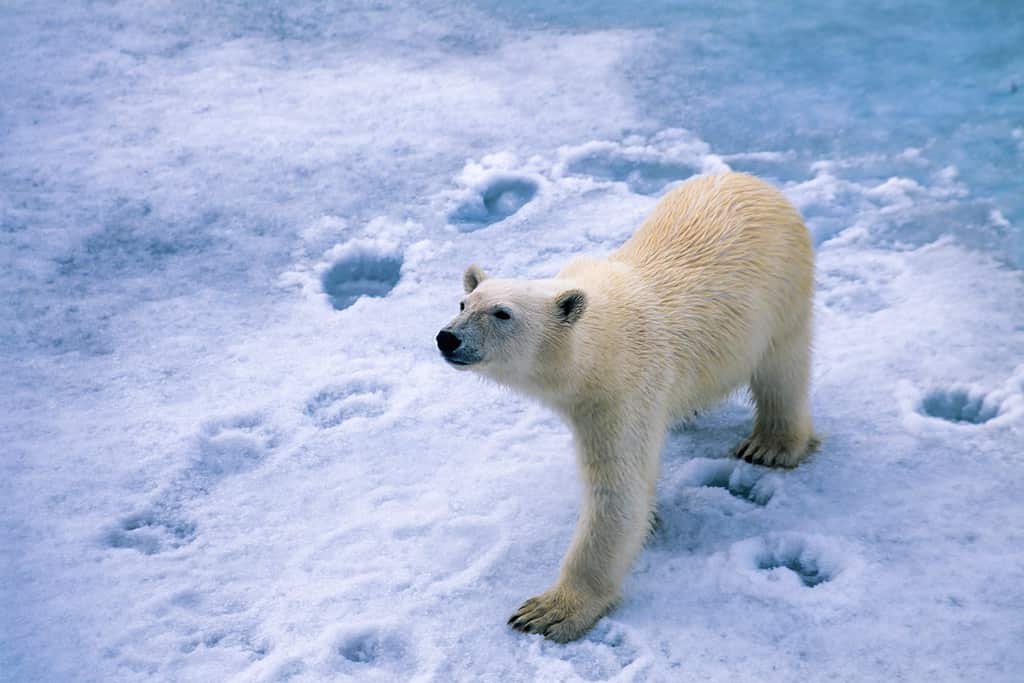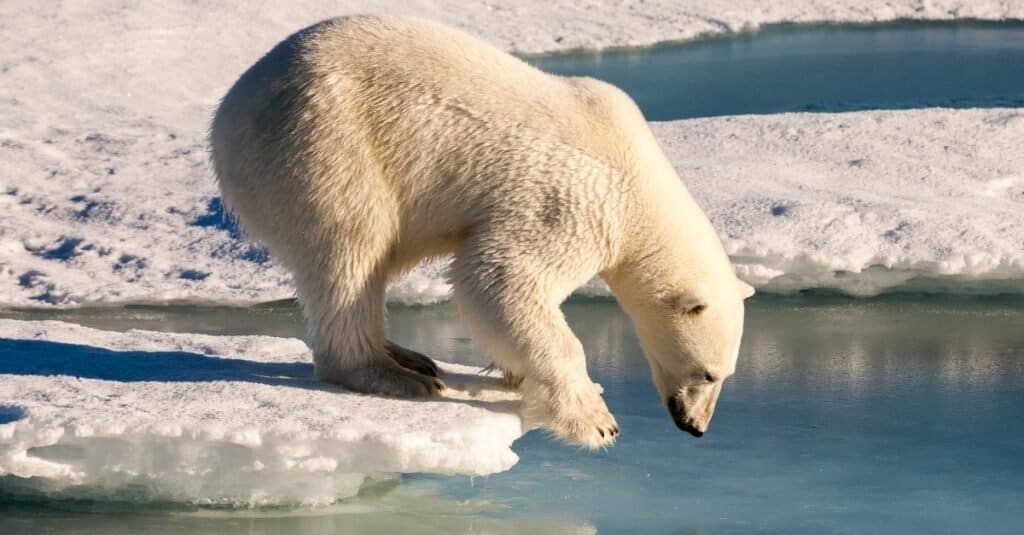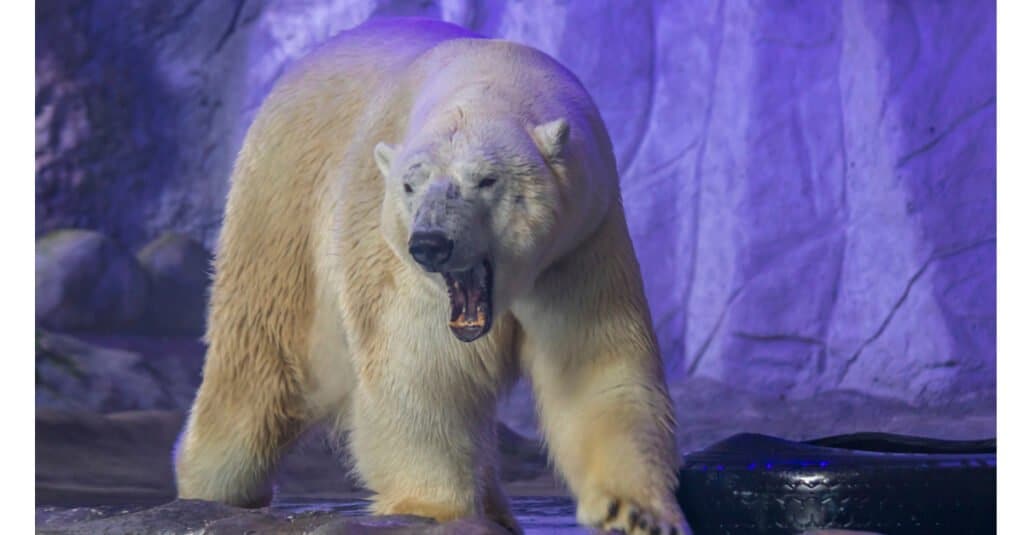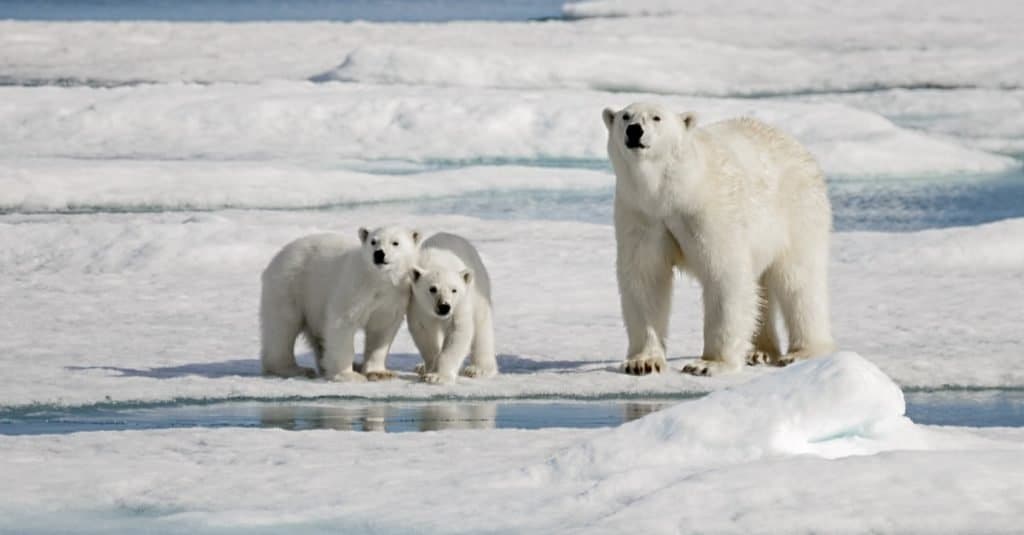Although Kodiak bears are close in size, polar bears are often considered the largest bear species in the world. These massive bears stalk the area north of the Arctic Circle, eating ringed seals, walruses, carrion, and other marine mammals. These creatures are unfortunately struggling with habitat loss and hunger these days, so extra-large specimens are rare. The largest polar bear ever weighed as much as a fishing boat. Find out where it was found along with three reasons why it grew so big!

How Large is the Average Polar Bear?
Before we consider the largest polar bear and how it got so big, we need some baseline measurements. On average, a polar bear will weigh between 330 pounds and 1,322 pounds. They also grow between 6.5 and 8.3 feet long.
Some estimates place the upper weight estimate closer to 1,500 pounds. Either way, these animals are incredibly large, and they are this size out of necessity. These apex predators spend much of their time in the water swimming. They have evolved large paws along with massive bodies insulated with a thick layer of fat that allows them to stay in cold water for long periods.

Polar bears have enormous paws and thick bodies.
©Lasse Johansson/Shutterstock.com
These bears travel great distances in search of food and stable ice, sometimes spending days walking and swimming. They need a lot of energy in the form of food to survive, but their size and power also help them obtain large meals from which they can gain nourishment.
How Big Was the Largest Polar Bear?

Polar bears are the world’s largest extant bears.
©Mario_Hoppmann/Shutterstock.com
| Measures | Average Polar Bear | Largest Polar Bear |
|---|---|---|
| Weight | 330-1,322 pounds | 2,209 |
| Length | 6.5 to 8.3 feet | 11 feet 1 inch |
The largest polar bear ever weighed 2,209 pounds and stood about 11 feet 1 inch tall on its hind legs. That means this bear weighed 700 pounds more than the upper end of a typical polar bear’s weight. Also, this monstrous bear was almost three feet longer than a polar bear’s typical size. The chart above demonstrates how unusual the bear was in terms of its overall size.
People spotted the largest polar bear in 1960. The creature was near Kotzebue Sound in Alaska. That is a bit farther south than the bears usually travel since it’s a transitional climate area.
Unfortunately, humans hunted and killed the bear after spotting it, and they later mounted its body. The bear was displayed during the 1962 Seattle World’s Fair. The bear’s enormous size makes one wonder how it managed to reach this size.
Why the Largest Polar Bear Weighed as Much as a Fishing Boat

Polar bears can swim for long distances and steadily for many hours to get from one piece of ice to another.
©Vladimir Gjorgiev/Shutterstock.com
Knowing the size of the largest polar bear, it is only fair to wonder how it achieved such an enormous size. What could make a polar bear grow about 1.5 to 2 times the size of a typical member of its species? While we will never know for sure, we can make some educated guesses about this animal. Consider these three following explanations for why this bear got so big.
1. The Bear Had the Right Genes

Some individuals just have the genes necessary to grow exceptionally large.
©imperio10/Shutterstock.com
The basis of any exceptionally large animal’s size has to be its genes. A human could take care of one polar bear by optimizing its diet, reducing the amount it must travel, and keeping it alive as long as possible. However, the chances of any polar bear getting as big as the largest polar bear in the world are quite low.
So, the largest polar bear weighed 2,209 pounds because it had the genetic predisposition to grow that size. The polar bear may have represented the uppermost size that the species can produce. Otherwise, it may have had a medical condition. An endocrine disease could have made the bear’s body produce too much growth hormone, making it grow much larger than it would have otherwise.
Even with the ability to reach such an enormous size encoded in the bear’s genes, the creature had to have other benefits as well. The following two factors also contributed to the bear’s size.
2. Dwindling Competition for Resources

Polar bear populations have rebounded, but they may drop again in the future.
©Alexey Seafarer/Shutterstock.com
The largest polar bear weighed as much as a fishing boat because it did not have to compete for food resources. During the 1960s, the polar bear population was suffering due to overhunting by humans. As a result, an estimated 5,000 to 12,000 polar bears were left during that time.
In 1973, the U.S., Canada, Denmark, USSR, and Norway signed an agreement to help conserve polar bears, finally placing regulations on hunting.
However, those regulations were not in place when the 2,209-pound polar bear was still around. That particular bear may have benefitted from diminished competition resulting from the falling population of fellow members of its species.
With fewer other apex predators eating the seals, walruses, carrion, and other meals, the extra-large polar bear could have had more food for itself. All that extra nutrition would have helped the bear grow much larger than it would today.
Current estimates say that about 26,000 polar bears are alive today. However, the bears’ habitat is dwindling as Arctic Sea ice continues to melt, and that is likely to hurt polar bear populations.
3. Access to Enormous Amounts of Food Meant Less Traveling

These bears often travel for hours or days to find food.
©Vaclav Sebek/Shutterstock.com
The fact that the polar bear likely had access to so much food in an era with a low polar bear population meant the creature did not have to travel as much. These days, bears can spend days in the water trying to get to a new ice slab. Swimming in the cold Arctic waters burns a lot of energy. So, polar bears constantly on the hunt are losing weight between meals.
The largest polar bear did not have to travel as far or to get its meals, so it continued to build up its weight rather than lose it. Also, the bear could have consumed a large meal when it was caught and killed, bolstering its weight for the scales.
Could Age Have Played a Part?
One more factor that can play a part in a bear’s size is its age. While the age of this particular polar bear is unknown, polar bears continue to grow as they age. Older bears are usually larger than younger ones. If this bear were an older individual, then its age could have played a part in its growing to such a massive size.
The largest polar bear weighed as much as a fishing boat and measured over 11 feet long. The creature reached that size with some mixture of amazing genetics, a lack of competition for food, and little need to travel for meals as polar bears do these days. Although the practice of hunting polar bears has been reined in, the animals are losing a lot of their territory. As a result, the polar bear population could once again sink in the coming decades.
Thank you for reading! Have some feedback for us? Contact the AZ Animals editorial team.








